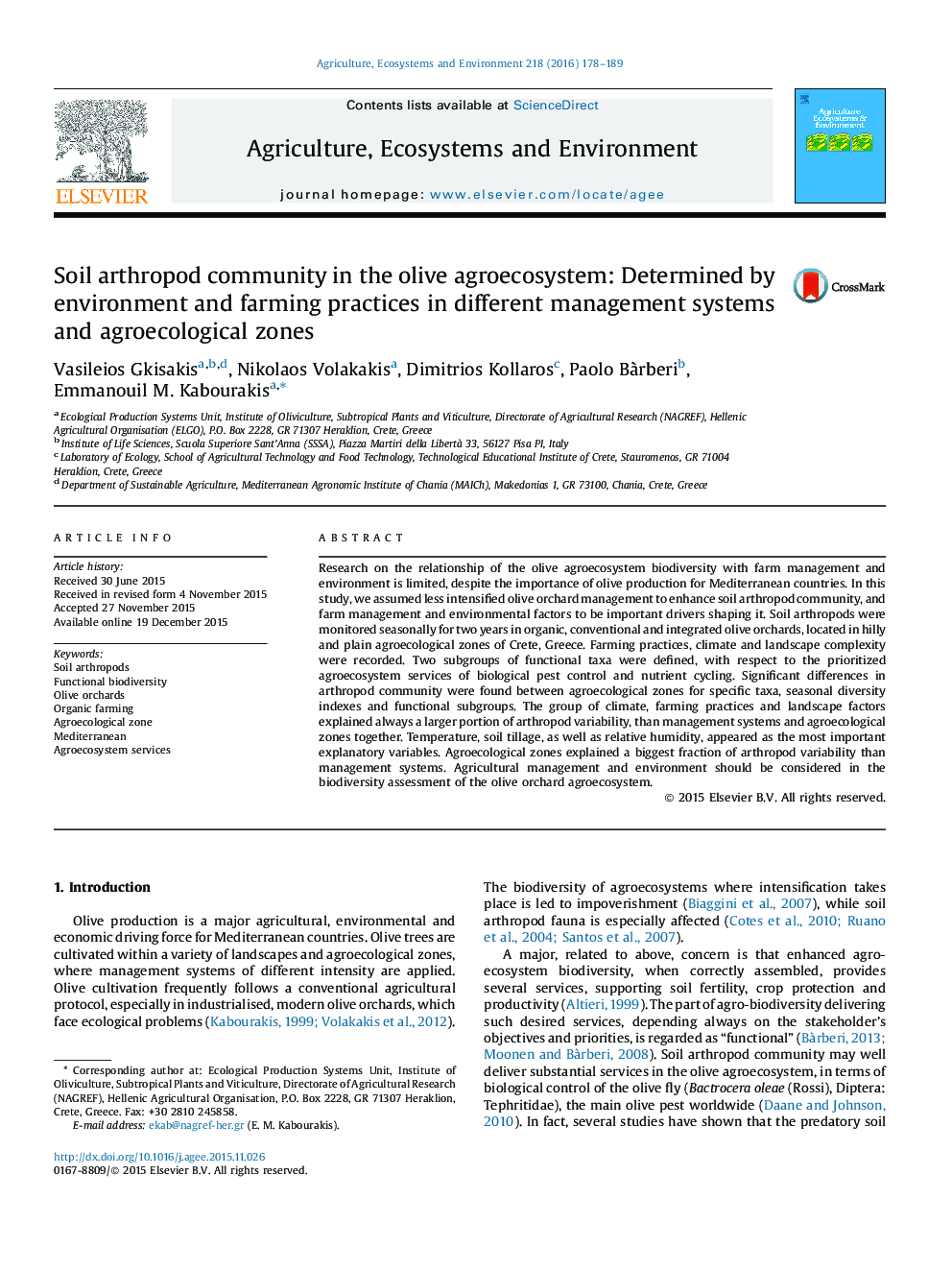| کد مقاله | کد نشریه | سال انتشار | مقاله انگلیسی | نسخه تمام متن |
|---|---|---|---|---|
| 8487561 | 1552034 | 2016 | 12 صفحه PDF | دانلود رایگان |
عنوان انگلیسی مقاله ISI
Soil arthropod community in the olive agroecosystem: Determined by environment and farming practices in different management systems and agroecological zones
ترجمه فارسی عنوان
انجمن جمعیت شهری روستایی در زراعت کشاورزی زیتون: تعیین شده توسط محیط زیست و شیوه های کشاورزی در سیستم های مختلف مدیریت و زراعت زراعی
دانلود مقاله + سفارش ترجمه
دانلود مقاله ISI انگلیسی
رایگان برای ایرانیان
کلمات کلیدی
ترجمه چکیده
با وجود اهمیت تولید زیتون برای کشورهای مدیترانه، تحقیق در رابطه با تنوع زیستی زراعت زراعت کشاورزی با مدیریت مزرعه و محیط زیست محدود است. در این مطالعه، مدیریت سبز زیتون تشدید شده را به منظور ارتقاء جمعیت شهری به کار می بریم و مدیریت مزرعه و عوامل محیطی به عنوان مهم ترین رانندگان آن شکل می گیرد. پرتقالهای خاکی به مدت دو سال در باغ های زیتون آلی، متعارف و یکپارچه، واقع در مناطق کوهستانی و کوهستانی یونان واقع در کوهستان و یونان قرار دارند. روش های کشاورزی، آب و هوا و پیچیدگی چشم انداز ثبت شد. دو زیرگروه تاکسونهای عملکردی با توجه به خدمات زراعی کشاورزی اولویت بندی کنترل آفات آفات و دوچرخه سواری مواد مغذی تعریف شده است. تفاوت های قابل توجهی در جامعه آرتروپود بین زیستگاه های زراعی و زراعی برای تاکسون های خاص، شاخص های تنوع فصلی و زیر گروه های عملکردی یافت شد. گروه آب و هوا، شیوه های کشاورزی و فاکتورهای چشم انداز همواره بخش بزرگی از تنوع زیستی ستون فقرات را از سیستم های مدیریتی و زیستگاه های زراعتی تقسیم می کنند. دمای، خاک و همچنین رطوبت نسبی به عنوان مهم ترین متغیرهای توضیحی به نظر می رسد. زیستگاه های زراعی، بزرگترین کسری از تنوع زیستی را نسبت به سیستم های مدیریتی توضیح دادند. مدیریت زیست محیطی و محیط زیست باید در ارزیابی تنوع زیستی زراعت زراعت باغبانی مورد توجه قرار گیرد.
موضوعات مرتبط
علوم زیستی و بیوفناوری
علوم کشاورزی و بیولوژیک
علوم زراعت و اصلاح نباتات
چکیده انگلیسی
Research on the relationship of the olive agroecosystem biodiversity with farm management and environment is limited, despite the importance of olive production for Mediterranean countries. In this study, we assumed less intensified olive orchard management to enhance soil arthropod community, and farm management and environmental factors to be important drivers shaping it. Soil arthropods were monitored seasonally for two years in organic, conventional and integrated olive orchards, located in hilly and plain agroecological zones of Crete, Greece. Farming practices, climate and landscape complexity were recorded. Two subgroups of functional taxa were defined, with respect to the prioritized agroecosystem services of biological pest control and nutrient cycling. Significant differences in arthropod community were found between agroecological zones for specific taxa, seasonal diversity indexes and functional subgroups. The group of climate, farming practices and landscape factors explained always a larger portion of arthropod variability, than management systems and agroecological zones together. Temperature, soil tillage, as well as relative humidity, appeared as the most important explanatory variables. Agroecological zones explained a biggest fraction of arthropod variability than management systems. Agricultural management and environment should be considered in the biodiversity assessment of the olive orchard agroecosystem.
ناشر
Database: Elsevier - ScienceDirect (ساینس دایرکت)
Journal: Agriculture, Ecosystems & Environment - Volume 218, 15 February 2016, Pages 178-189
Journal: Agriculture, Ecosystems & Environment - Volume 218, 15 February 2016, Pages 178-189
نویسندگان
Vasileios Gkisakis, Nikolaos Volakakis, Dimitrios Kollaros, Paolo BÃ rberi, Emmanouil M. Kabourakis,
